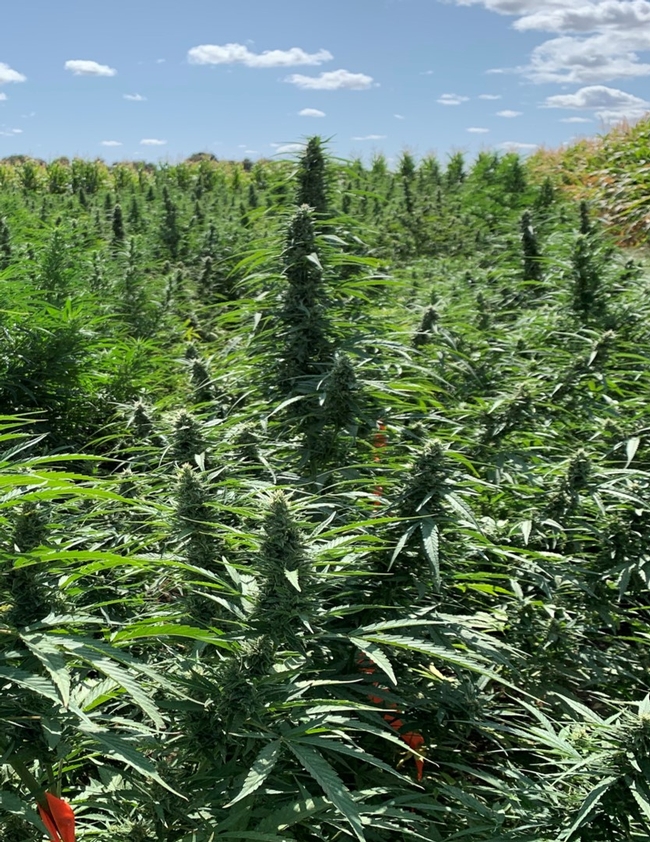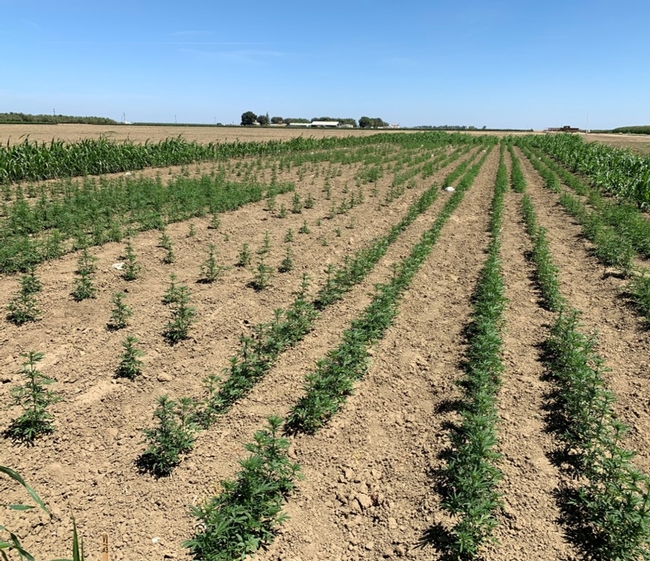UC Agriculture and Natural Resources hemp research continues in 2020
Opportunities and challenges for industrial hemp production in California are being revealed in a series of UC Cooperative Extension research projects.
As a crop relatively new to California growers and researchers, there is still much to learn about variety choices, how varieties and crop responses differ across regions with different soils and climates, best practices for nutrient management, and pest and disease issues.
UCCE industrial hemp field research efforts began in 2019 after the previous year's Farm Bill declared the crop should no longer be considered a controlled substance, but rather an agricultural commodity. Hemp is valued for its fiber and edible seeds, however, in California, producing hemp for essential oils including medicinal cannabidiol (CBD) is thought to offer the best economic outlook.
2020 studies with Front Range Biosciences
UCCE is working with Lafayette, Colo.-based Front Range Biosciences to test 10 of the company's hemp varieties in Ventura County and the west side of Fresno County. In Fresno County, the trial is underway at the UC West Side Research and Extension Center (West Side REC) under the direction of UCCE specialist Bob Hutmacher. UC Cooperative Extension advisor Annemiek Schilder, the study leader in Ventura County, intended to conduct the trial at the UC Hansen Research and Extension Center in Santa Paula, but the Ventura County Board of Supervisors enacted an emergency ordinance in January prohibiting hemp fields within a half mile of residential areas and schools because of the odor.
“The odor can be quite strong,” Schilder said. “Once plants start flowering, some varieties smell skunky. But the crop is related to hops, and other varieties have a more pleasant hoppy smell. Weather conditions also play a role in odor complaints.”
The Ventura County industrial hemp trial was planted at an Oxnard farm where a hemp crop was already being grown.
The trial includes mostly photoperiod-sensitive cultivars, where the flowering response is triggered by shortening day lengths in mid- to late summer in this latitude. Varieties that do not require the shortening day length to flower are called auto-flower varieties.
“Industrial hemp cultivars grown for essential oils, such as CBD, can be photoperiod-sensitive or not sensitive,” Hutmacher said. “The auto-flower varieties have potential to be more versatile in some production systems, in that they could be planted at a broader range of times of year since they don't respond to day length.”
The studies include growth and yield evaluations, monitoring for pest or disease threats in the San Joaquin Valley and coastal California, and periodic plant sampling to monitor the changes in plant THC and CBD levels over time. THC (tetrahydrocannabinol) is the psychoactive compound found in greater concentrations in cannabis varieties grown for marijuana. Legal requirements for industrial hemp production for essential oils, fiber or seed mandate monitoring concentrations of THC. The crop may not exceed 0.3% at harvest or it must be destroyed.
2020 cooperative irrigation study with Oregon State University
In a new 2020 study led by Oregon State University, drip irrigation trials were set up in California at the UC West Side REC and the UC Davis campus in addition to three sites in Oregon. These studies were set up to determine water use of industrial hemp under irrigation regimes ranging from about 40% to 100% of estimated crop water requirements, with comparisons of responses observed across the five sites with different soils, climate and other environmental conditions.
The same four varieties (two auto-flower and two photoperiod-sensitive) are being grown in irrigation studies at each of the five sites. The California locations in these trials were both planted in mid-June. The two auto-flowering varieties were harvested in late August and early September. The researchers expect to harvest photoperiod-sensitive types in late September or October.
The total water use of the different hemp cultivars under the different irrigation regimes will be determined using applied water measurements and assessments of soil water use between planting and harvest for each cultivar.
Some of the irrigation treatments impose moderate to more severe deficit irrigation to help assess the crop responses to water stress. Deficit irrigation is a method of conserving water by applying less than what might be considered optimum for maintaining rapid growth.
“This plant appears to be quite tough under deficit irrigation,” Hutmacher said. “We need to learn more about benefits and drawbacks to stressing the plants.”
The auto-flower cultivars tested have used less water than the photoperiod-sensitive cultivars because they can be grown in a shorter season. In the San Joaquin Valley, auto-flower cultivars in these studies were ready for harvest in 75 to 90 days after seeding.
“Auto-flower varieties may have potential to be grown in the spring and harvested by early summer, or planted in late summer and harvested before winter. With a short-season crop, and with a decent water supply, farmers could consider double-cropping with such varieties, increasing profits,” Hutmacher said.
2019 and 2020 planting density studies
In cooperation with Kayagene Company in Salinas, Dan Putnam, UCCE alfalfa specialist at UC Davis, and Hutmacher have conducted studies in 2019 and 2020 with two auto-flower varieties to determine crop growth, yield and THC and CBD concentrations of planting densities ranging from about 7,500 plants per acre to 30,000 plants per acre. Since some of the auto-flower varieties are smaller and earlier maturing than many photoperiod-sensitive cultivars, data in these studies will help determine the tradeoff between higher densities needed to increase yields versus increases in the cost of growing more plants.
The studies also provided opportunities for the scientists to assess plant-to-plant variation and impacts of flower bud position on THC and CBD concentrations.
“We feel that when this type of basic sampling method data is collected across a range of cultivars differing in plant growth habit, it may help better inform both researchers and regulatory groups in decisions regarding how to monitor plant chemical composition,” Hutmacher said.
Hutmacher and Putnam are also working with scientists at Davis-based Arcadia Biosciences to refine sampling methods.
“There are a lot of challenges when it comes to estimating maturity with these varieties,” Putnam said. “Each variety will mature at different times and deciding when is the best time is a key decision.”


